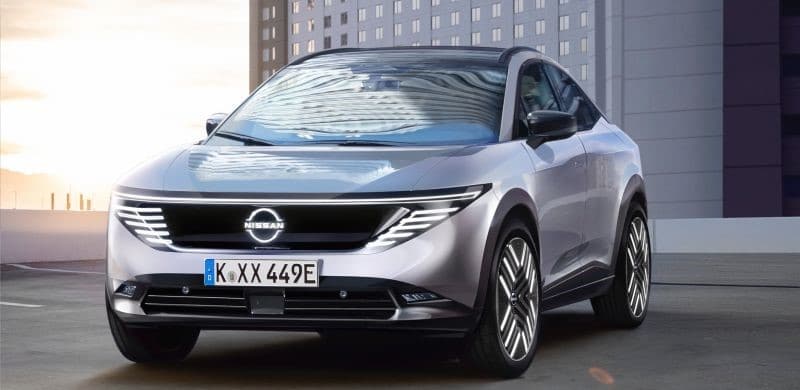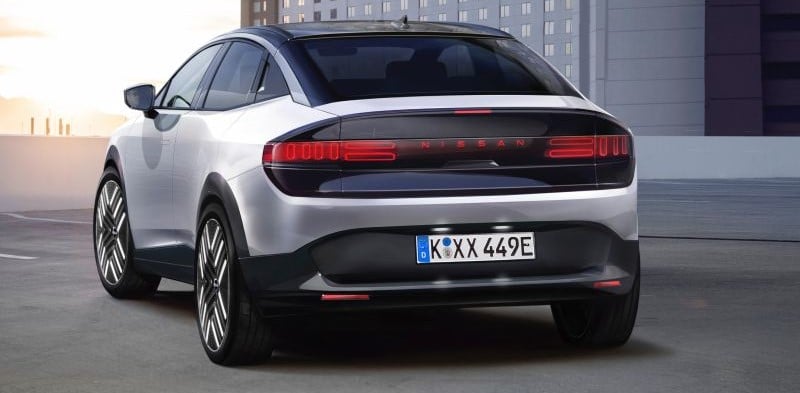Will Sleek New Leaf Design Save Nissan?
Nissan is currently navigating a complex mix of challenges and strategic efforts aimed at revitalizing the company. In November, the carmaker made headlines for selling part of its stake in Mitsubishi, signaling financial difficulties. Reports also hinted that Nissan might only have a year to recover before potentially facing a major restructuring, including the possibility of selling a majority stake to a rival like Honda.
Nissan, once a prominent force in the global automotive industry, is now grappling with a significant financial crisis. The company recently reported a staggering 90% drop in profits compared to the previous year, highlighting the intense challenges it faces in a market that is becoming increasingly competitive and evolving rapidly. The shift towards electric vehicles (EVs) has been particularly difficult for the company as it struggles to adapt to the growing dominance of China in the EV sector, which has left many global competitors, including Nissan, scrambling to keep up. This shift has affected Nissan’s overall global sales, which fell by 3.8% to 1.59 million vehicles in the first half of the financial year. The situation is even more critical in China, where Nissan’s sales dropped by 14.3%, a reflection of the company’s struggles in one of the world’s largest and most competitive automotive markets.
To address these dire circumstances, Nissan has announced a series of drastic restructuring measures. The company plans to eliminate 9,000 jobs globally and reduce its manufacturing output by 20%. These steps are aimed at stabilizing the company’s operations as it faces declining sales, rising production costs, and increasing competition, especially from Chinese automakers and EV companies. However, these cuts are likely to have a deep impact, not only on the company’s workforce but also across the broader industry, as Nissan has been a key player in the global automotive market for decades.
A significant factor contributing to Nissan’s poor performance in recent years is its underwhelming presence in the EV market. As of Q3 2024, Nissan held just a 2.4% market share in the electric vehicle sector, according to Kelley Blue Book’s Quarterly Sales of Electric Vehicles report. This market share, combined with a lack of new, competitive battery electric vehicle (BEV) models, has likely been a major factor in Nissan’s financial troubles. While competitors, as well as Chinese automakers, have made rapid advancements in EV technology and market share, Nissan’s hesitancy and slower pace in introducing new models have put it at a disadvantage. As the industry increasingly shifts toward EVs, this delay in adapting to the new landscape has left Nissan playing catch-up.
The company’s current challenges reflect the broader struggle faced by many traditional automakers as they work to transition to electric mobility while maintaining profitability. The restructuring measures and job cuts are painful but may be necessary steps for Nissan to regain its footing in an increasingly competitive automotive world. Whether these actions will be enough to turn the company’s fortunes around remains to be seen, but Nissan will need to act quickly to stay relevant in the global market.
Positive Developments in December
However, December brought more positive developments. Nissan kicked off production of the important 2025 Murano mid-size crossover SUV in Smyrna, Tennessee, signaling confidence in its SUV portfolio amid strong consumer demand for these vehicles. Additionally, the Nissan Energy Charge Network (NECN) expanded significantly, incorporating nearly 18,000 Tesla Superchargers across the U.S. and Canada. This move underlined Nissan’s commitment to bolstering its electric vehicle (EV) infrastructure, making EVs more accessible to a wider audience. Furthermore, Nissan announced a leadership shake-up, with a new team set to take over in January 2025, and Christian Meunier appointed as the new chairman of Nissan Americas, indicating a fresh direction for the company.

Sleek New Leaf Design
As Nissan looks ahead, its efforts to recover extend to the world of digital car design. One such effort is the work of Larson Design’s Lars Sältzer, a virtual artist who created a CGI concept for the third-generation Nissan Leaf. The Leaf, once the world’s best-selling EV, now finds itself in a less prominent position in the EV market, with its current second-generation model dating back to 2017. The Leaf’s design has often been criticized as outdated, and while it remains one of the most affordable EVs in the U.S., starting at $28,140 for the 2025 model, its hatchback body style seems less appealing compared to newer, more stylish competitors.
In response, Larson Design’s vision for the next Leaf is a crossover-style fastback, drawing inspiration from Nissan’s Chill-Out concept, which could give the Leaf a more modern and appealing look. The new design would likely aim to compete with vehicles like the Toyota Prius, offering both hybrid and plug-in hybrid options. The concept also suggests that Nissan might adopt Renault’s AmpR platform for the third-generation Leaf, positioning it to rival models like the Renault Megane E-Tech Electric. This new Leaf could feature a hp of 217 and a 60-kWh battery.
With a revamped leadership team, an expanding EV infrastructure, and potential new sleek vehicle designs such as those by Larson Designs, Nissan is actively positioning itself for a comeback. While the company faces significant challenges, especially with the evolving EV market and competition from both traditional and new automakers, these efforts suggest Nissan is serious about reclaiming its place in the automotive landscape. The upcoming Tokyo Auto Salon 2025, where new designs and concepts will be unveiled, could provide a glimpse into Nissan’s next steps as it works to overcome its financial troubles and market struggles.

A New, Sleek Makeover Saved the Toyota Prius
The Prius is a game-changing vehicle, which ushered in a world where hybrid-powered fuel efficiency was not the alternative, but rather the norm. Now, with over 5 million units sold in North America, and over 20 million globally, Toyota hybrids are not only a common sight, but they have made a difference, too, preventing over 82 million tons of CO2 emissions from entering the atmosphere. However, the vehicle was much maligned for it’s boxy, unattractive design. Larson Design’s vision for the new Nissan Leaf reminds us how Toyota’s sporty facelift of its Prius saved the vehicle from certain death.

The legendary Toyota Prius nameplate has once again proven that it remains at the forefront of automotive innovation, with the reveal of the all-new, sleek redesign of the 2023 Prius and Prius Prime. The launch took place on the eve of the 2022 Los Angeles Auto Show at the LA Convention Center, marking a bold new chapter for the iconic hybrid. Designed in Japan, the new Prius introduces a modern, progressive, and understated style, both inside and out. The vehicle features a sharp, aerodynamic silhouette that enhances its visual appeal, with the roofline lowered by 2 inches compared to the previous generation, giving the car a more athletic, streamlined appearance.
At the rear, the new Prius is nearly 1 inch wider, adding to its dynamic and modern stance. The larger wheels available on the XLE and Limited trims further contribute to the sporty aesthetic, while also providing drivers with improved performance and handling. Inside, the vehicle’s design places the hip point about an inch lower than the previous generation, improving driving dynamics and comfort. The placement of the battery has been optimized for a lower center of gravity, which not only enhances the handling but also allows for greater luggage capacity, making the new Prius more practical for daily use. With these changes, the 2023 Prius continued its legacy as a leader in the hybrid and plug-in hybrid segments, combining sleek design, improved performance, and enhanced utility.
Hybrids Growing Fast in America
Plug-in hybrid electric vehicles (PHEVs) are increasingly seen as a crucial bridge to full battery electric vehicle (BEV) adoption. The argument against traditional hybrid electric vehicles (HEVs), which combine a gas engine and electric motor but lack a plug for charging, is becoming stronger. EVinfo.net suggests that if you’re considering a hybrid, PHEVs are the better option—provided drivers remember to plug them in. Failing to do so often reverts the vehicle back to functioning as a conventional internal combustion engine (ICE) car, negating the benefits of electric driving.
The rise of PHEVs can be attributed to ongoing challenges with EV charging infrastructure, especially in areas where multifamily dwellers, who make up nearly a third of the U.S. population, lack access to home charging. Home charging remains the most cost-effective and convenient solution for EV owners, but for many, it’s still not an option. As a result, PHEVs offer a practical middle ground, allowing drivers to rely on electric power for shorter trips while still having the backup of a gas engine for longer journeys.
Given these conditions, it’s expected that the production and adoption of PHEVs will continue to grow, while the market for non-plug-in HEVs will likely shrink. In fact, the transition to BEVs, HEVs, and PHEVs will probably happen faster than many expect, with the last fully gas-powered ICE vehicle being produced sooner than predicted. As PHEVs and BEVs gain traction, the market share for traditional HEVs in America will continue to decline, with more drivers making the shift toward electrified options as infrastructure and consumer preferences evolve.

Electric Vehicle Marketing Consultant, Writer and Editor. Publisher EVinfo.net.
Services